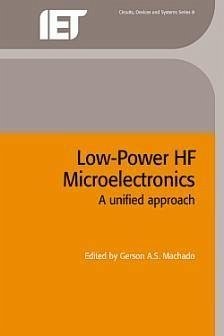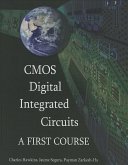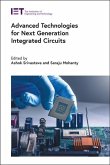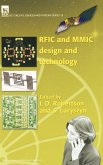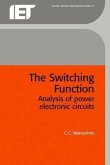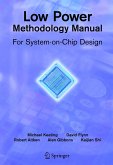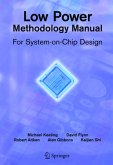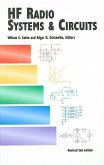Low-Power Hf Microelectronics: A Unified Approach
Herausgeber: Machado, Gerson A. S.
Low-Power Hf Microelectronics: A Unified Approach
Herausgeber: Machado, Gerson A. S.
- Gebundenes Buch
- Merkliste
- Auf die Merkliste
- Bewerten Bewerten
- Teilen
- Produkt teilen
- Produkterinnerung
- Produkterinnerung
This book brings together innovative modelling, simulation and design techniques in CMOS, SOI, GaAs and BJT to achieve successful high-yield manufacture for low-power, high-speed and reliable-by-design analogue and mixed-mode integrated systems.
Andere Kunden interessierten sich auch für
![CMOS Digital Integrated Circuits: A First Course CMOS Digital Integrated Circuits: A First Course]() Charles HawkinsCMOS Digital Integrated Circuits: A First Course150,99 €
Charles HawkinsCMOS Digital Integrated Circuits: A First Course150,99 €![Advanced Technologies for Next Generation Integrated Circuits Advanced Technologies for Next Generation Integrated Circuits]() Advanced Technologies for Next Generation Integrated Circuits159,99 €
Advanced Technologies for Next Generation Integrated Circuits159,99 €![Rfic and MMIC Design and Technology Rfic and MMIC Design and Technology]() Rfic and MMIC Design and Technology190,99 €
Rfic and MMIC Design and Technology190,99 €![The Switching Function: Analysis of Power Electronic Circuits The Switching Function: Analysis of Power Electronic Circuits]() C. C. MarouchosThe Switching Function: Analysis of Power Electronic Circuits151,99 €
C. C. MarouchosThe Switching Function: Analysis of Power Electronic Circuits151,99 €![Low Power Methodology Manual Low Power Methodology Manual]() David FlynnLow Power Methodology Manual145,99 €
David FlynnLow Power Methodology Manual145,99 €![Low Power Methodology Manual Low Power Methodology Manual]() David FlynnLow Power Methodology Manual105,99 €
David FlynnLow Power Methodology Manual105,99 €![Hf Radio Systems and Circuits Hf Radio Systems and Circuits]() Hf Radio Systems and Circuits148,99 €
Hf Radio Systems and Circuits148,99 €-
-
-
This book brings together innovative modelling, simulation and design techniques in CMOS, SOI, GaAs and BJT to achieve successful high-yield manufacture for low-power, high-speed and reliable-by-design analogue and mixed-mode integrated systems.
Hinweis: Dieser Artikel kann nur an eine deutsche Lieferadresse ausgeliefert werden.
Hinweis: Dieser Artikel kann nur an eine deutsche Lieferadresse ausgeliefert werden.
Produktdetails
- Produktdetails
- Materials, Circuits and Device
- Verlag: Institution of Engineering & Technology
- Seitenzahl: 1062
- Erscheinungstermin: Juni 1996
- Englisch
- Abmessung: 236mm x 160mm x 53mm
- Gewicht: 1406g
- ISBN-13: 9780852968741
- ISBN-10: 0852968744
- Artikelnr.: 50911723
- Herstellerkennzeichnung
- Libri GmbH
- Europaallee 1
- 36244 Bad Hersfeld
- gpsr@libri.de
- Materials, Circuits and Device
- Verlag: Institution of Engineering & Technology
- Seitenzahl: 1062
- Erscheinungstermin: Juni 1996
- Englisch
- Abmessung: 236mm x 160mm x 53mm
- Gewicht: 1406g
- ISBN-13: 9780852968741
- ISBN-10: 0852968744
- Artikelnr.: 50911723
- Herstellerkennzeichnung
- Libri GmbH
- Europaallee 1
- 36244 Bad Hersfeld
- gpsr@libri.de
* Chapter 1: Low-power HF microelectronics: a unified approach
* Part 1: Process technology
* Chapter 2: Device structures and device simulation techniques
* Chapter 3: Stanford's ultra-low-power CMOS technology and
applications
* Chapter 4: SOI technology
* Chapter 5: Radiation effects on ICs and a mixed analog
CMOS-NPN-PJFET-on-insulator technology
* Part 2: Device modelling/characterisation and circuit simulation
* Chapter 6: Modelling and characterisation of GaAs devices
* Chapter 7: The EKV Model: a MOST Model Dedicated to Low-Current and
Low-Voltage Analogue Circuit Design and Simulation
* Chapter 8: Non-linear dynamic modelling of RF bipolar transistors
* Chapter 9: APLAC - object-oriented circuit simulator and design tool
* Chapter 10: Noise coupling in mixed-signal ASICs
* Part 3: Reliability and test
* Chapter 11: Robust design and reliability analysis
* Chapter 12: Dynamic reliability of systems
* Chapter 13: Fault modelling and simulation for the test of integrated
analog and mixed-signal circuits
* Part 4: Circuit and system design methodology
* Chapter 14: High-speed and low-power techniques in CMOS and BiCMOS
* Chapter 15: Ultra-low-power digital design
* Chapter 16: Matched delay technique for high-speed digital design
* Chapter 17: Statistical design and optimisation for high-yield BiCMOS
analog circuits
* Chapter 18: Design considerations for high-speed amplifiers using
complementary BJTs
* Chapter 19: S2I techniques for analog sampled-data signal processing
* Chapter 20: Design of wireless portable systems
* Chapter 21: Low-power radio-frequency ICs and system architectures
for portable communications
* Chapter 22: Analog and digital CMOS design for spread-spectrum
wireless communications
* Chapter 23: Design considerations for BJT active mixers
* Chapter 24: Distortion in short channel FET circuits
* Chapter 25: Intelligent sensor systems and smart sensors: concepts,
focus points and technology
* Chapter 26: Intelligent sensor systems and smart sensors:
applications
* Part 1: Process technology
* Chapter 2: Device structures and device simulation techniques
* Chapter 3: Stanford's ultra-low-power CMOS technology and
applications
* Chapter 4: SOI technology
* Chapter 5: Radiation effects on ICs and a mixed analog
CMOS-NPN-PJFET-on-insulator technology
* Part 2: Device modelling/characterisation and circuit simulation
* Chapter 6: Modelling and characterisation of GaAs devices
* Chapter 7: The EKV Model: a MOST Model Dedicated to Low-Current and
Low-Voltage Analogue Circuit Design and Simulation
* Chapter 8: Non-linear dynamic modelling of RF bipolar transistors
* Chapter 9: APLAC - object-oriented circuit simulator and design tool
* Chapter 10: Noise coupling in mixed-signal ASICs
* Part 3: Reliability and test
* Chapter 11: Robust design and reliability analysis
* Chapter 12: Dynamic reliability of systems
* Chapter 13: Fault modelling and simulation for the test of integrated
analog and mixed-signal circuits
* Part 4: Circuit and system design methodology
* Chapter 14: High-speed and low-power techniques in CMOS and BiCMOS
* Chapter 15: Ultra-low-power digital design
* Chapter 16: Matched delay technique for high-speed digital design
* Chapter 17: Statistical design and optimisation for high-yield BiCMOS
analog circuits
* Chapter 18: Design considerations for high-speed amplifiers using
complementary BJTs
* Chapter 19: S2I techniques for analog sampled-data signal processing
* Chapter 20: Design of wireless portable systems
* Chapter 21: Low-power radio-frequency ICs and system architectures
for portable communications
* Chapter 22: Analog and digital CMOS design for spread-spectrum
wireless communications
* Chapter 23: Design considerations for BJT active mixers
* Chapter 24: Distortion in short channel FET circuits
* Chapter 25: Intelligent sensor systems and smart sensors: concepts,
focus points and technology
* Chapter 26: Intelligent sensor systems and smart sensors:
applications
* Chapter 1: Low-power HF microelectronics: a unified approach
* Part 1: Process technology
* Chapter 2: Device structures and device simulation techniques
* Chapter 3: Stanford's ultra-low-power CMOS technology and
applications
* Chapter 4: SOI technology
* Chapter 5: Radiation effects on ICs and a mixed analog
CMOS-NPN-PJFET-on-insulator technology
* Part 2: Device modelling/characterisation and circuit simulation
* Chapter 6: Modelling and characterisation of GaAs devices
* Chapter 7: The EKV Model: a MOST Model Dedicated to Low-Current and
Low-Voltage Analogue Circuit Design and Simulation
* Chapter 8: Non-linear dynamic modelling of RF bipolar transistors
* Chapter 9: APLAC - object-oriented circuit simulator and design tool
* Chapter 10: Noise coupling in mixed-signal ASICs
* Part 3: Reliability and test
* Chapter 11: Robust design and reliability analysis
* Chapter 12: Dynamic reliability of systems
* Chapter 13: Fault modelling and simulation for the test of integrated
analog and mixed-signal circuits
* Part 4: Circuit and system design methodology
* Chapter 14: High-speed and low-power techniques in CMOS and BiCMOS
* Chapter 15: Ultra-low-power digital design
* Chapter 16: Matched delay technique for high-speed digital design
* Chapter 17: Statistical design and optimisation for high-yield BiCMOS
analog circuits
* Chapter 18: Design considerations for high-speed amplifiers using
complementary BJTs
* Chapter 19: S2I techniques for analog sampled-data signal processing
* Chapter 20: Design of wireless portable systems
* Chapter 21: Low-power radio-frequency ICs and system architectures
for portable communications
* Chapter 22: Analog and digital CMOS design for spread-spectrum
wireless communications
* Chapter 23: Design considerations for BJT active mixers
* Chapter 24: Distortion in short channel FET circuits
* Chapter 25: Intelligent sensor systems and smart sensors: concepts,
focus points and technology
* Chapter 26: Intelligent sensor systems and smart sensors:
applications
* Part 1: Process technology
* Chapter 2: Device structures and device simulation techniques
* Chapter 3: Stanford's ultra-low-power CMOS technology and
applications
* Chapter 4: SOI technology
* Chapter 5: Radiation effects on ICs and a mixed analog
CMOS-NPN-PJFET-on-insulator technology
* Part 2: Device modelling/characterisation and circuit simulation
* Chapter 6: Modelling and characterisation of GaAs devices
* Chapter 7: The EKV Model: a MOST Model Dedicated to Low-Current and
Low-Voltage Analogue Circuit Design and Simulation
* Chapter 8: Non-linear dynamic modelling of RF bipolar transistors
* Chapter 9: APLAC - object-oriented circuit simulator and design tool
* Chapter 10: Noise coupling in mixed-signal ASICs
* Part 3: Reliability and test
* Chapter 11: Robust design and reliability analysis
* Chapter 12: Dynamic reliability of systems
* Chapter 13: Fault modelling and simulation for the test of integrated
analog and mixed-signal circuits
* Part 4: Circuit and system design methodology
* Chapter 14: High-speed and low-power techniques in CMOS and BiCMOS
* Chapter 15: Ultra-low-power digital design
* Chapter 16: Matched delay technique for high-speed digital design
* Chapter 17: Statistical design and optimisation for high-yield BiCMOS
analog circuits
* Chapter 18: Design considerations for high-speed amplifiers using
complementary BJTs
* Chapter 19: S2I techniques for analog sampled-data signal processing
* Chapter 20: Design of wireless portable systems
* Chapter 21: Low-power radio-frequency ICs and system architectures
for portable communications
* Chapter 22: Analog and digital CMOS design for spread-spectrum
wireless communications
* Chapter 23: Design considerations for BJT active mixers
* Chapter 24: Distortion in short channel FET circuits
* Chapter 25: Intelligent sensor systems and smart sensors: concepts,
focus points and technology
* Chapter 26: Intelligent sensor systems and smart sensors:
applications

